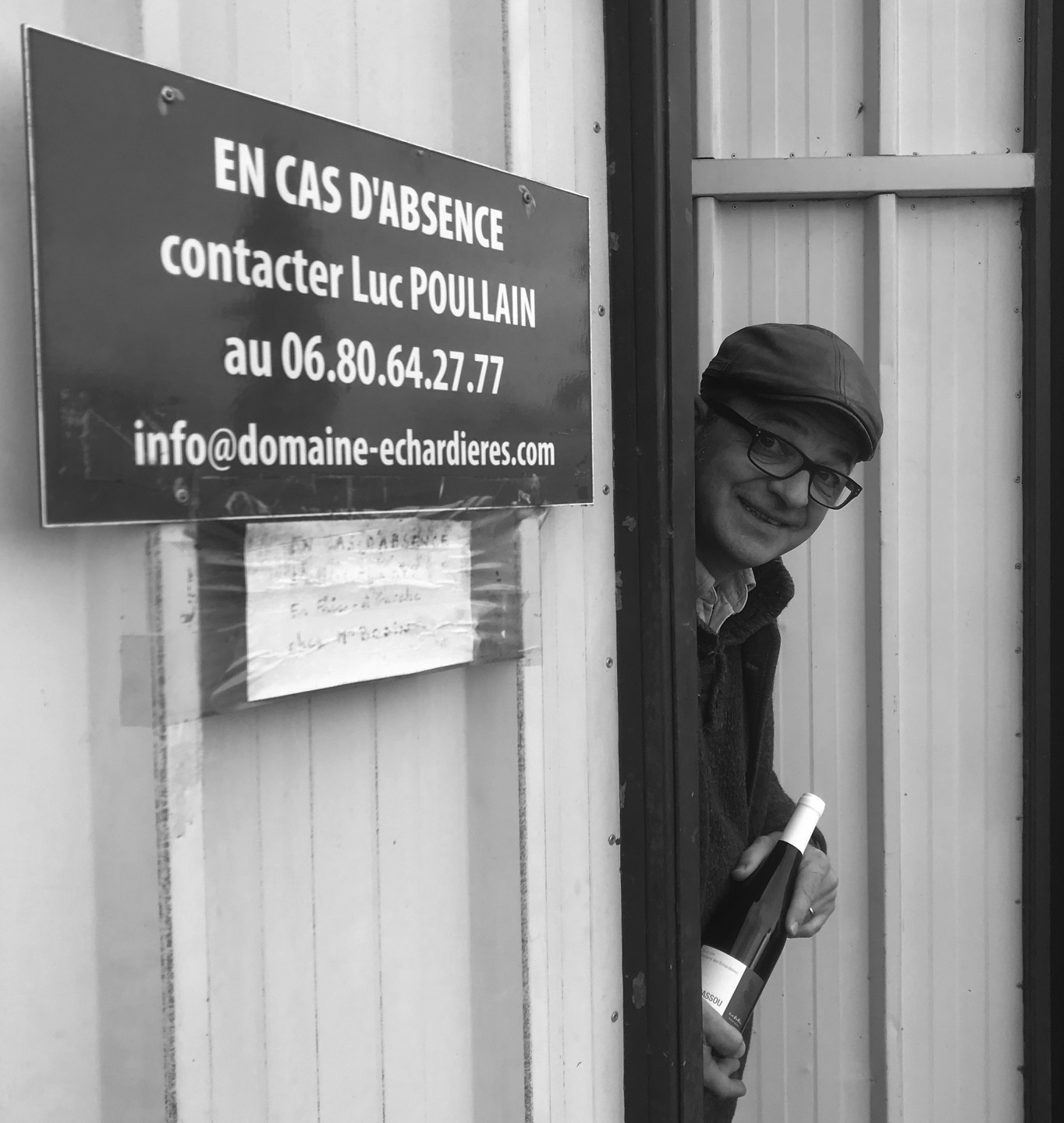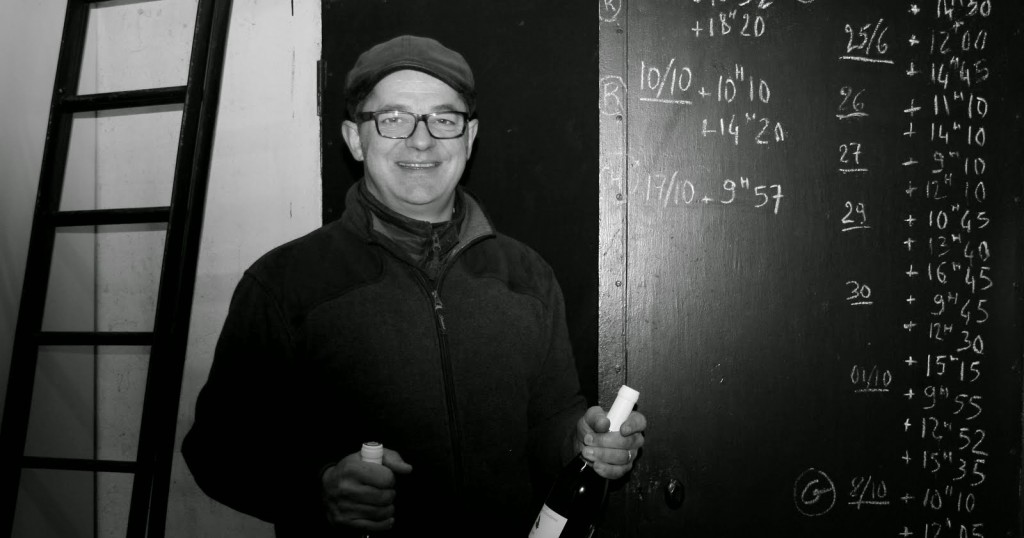
Luc Poullain bought Domaine des Echardières and its 16 hectares of vines as a going concern in 2000 from one of the many divisions of the local Launay clan. He was 30 years old at the time. An interesting career path, he’d studied as an agricultural engineer in Bedfordshire in the early 1990s (which rather explains his excellent grasp of the English language), before returning to France to sell, ironically, chemicals to the wine industry.
Although the cellar is situated in the village of Angé, the vines are located on what is referred to as the Premier Côte between here and the neighbouring commune of Pouillé – where Luc and his family live. Split almost equally white and red, there are seven hectares of Sauvignon, planted on two different soil types (both flint and limestone) and which are vinified apart.

Luc makes two expressions of Sauvignon: a machine harvested Touraine appellation wine and, more recently, he has also taken advantage of the new Touraine-Chenonceaux AoC.
Named after the famous Renaissance château, the appellation came into effect in 2011 and exists for red and white wine, selected from the best vineyard sites spread across 27 different communes on both sides of the Cher. As the current President of the growers’ syndicat, Luc is a proud defender of what the producers of Touraine-Chenonceaux appellation sets out to achieve.
The white is invariably made from Sauvignon with most of the 30 producers who have signed up for the right to produce wines located in the villages of Pouillé, Thésée and Saint-Aignan. The law lays own strict instructions in terms of yields and release date: a maximum of 55hl/hectare with the wines only allowed to be commercialised after the 1st May following the harvest, thus allowing, in theory, more time on their lees. The appellation law also demands that that both wines be committed to an exclusive (Italian designed) bottle for ease of recognition.
The Touraine-Chenonceaux reds are an equal blend of Cabernet Franc and Côt (Malbec). One has to recognise that this is at the eastern extremity of the maritime climate favoured by the Breton (Cabernet Franc) grape where maturity is by no means guaranteed every year. It needs to be planted in the correct soils on the most precocious sites – and yet still needs warm growing conditions in order to ripen.
For a long period of time, Malbec has been seen as being most adapted to the part-continental climes of the Cher valley. Better vineyard management, however, combined with improved cellar techniques along with the effect of global warming has resulted in red wines with greater ripeness and overall quality in this part of Touraine over the past decade. Raised in tank, the law here dictates that the wines are not to be released before September 1st in the year following the vintage.
Also in Luc’s range is a simple Touraine Rouge known as Le Bécassou (in acknowledgment to Luc’s passion for hunting) which is a blend of Gamay, Cabernet Franc and Malbec, along with an excellent dry Touraine Rosé made from the same three varieties.
SAUVIGNON DE TOURAINE
They call Luc Poullain ‘Mister President’ in these parts, being the brains behind the relatively newly created Touraine-Chenonceaux appellation.
He speaks English better than most British people I know having studied agriculture in Bedfordshire, before taking over Domaine des Echardières from a retiring vigneron in 2000. His passion is for hunting (as well as actively being involved in the preservation of) Woodcock, known colloquially in these parts as La Long Bec.
Luc’s Sauvignon Blanc is sourced from vineyards on the slopes and plateaux on the south bank of the river Cher, where soil types match those of his more illustrious Sauvignon Blanc neighbours further to the east, with his wine is as good a match as any of those and at significantly more attractive pricing
TOURAINE ROSÉ
They call Luc Poullain ‘Mister President’ in these parts, being the brains behind the relatively newly created Touraine-Chenonceaux appellation.
He speaks English better than most British people I know having studied agriculture in Bedfordshire, before taking over Domaine des Echardières from a retiring vigneron in 2000. His passion is for hunting (as well as actively being involved in the preservation of) Woodcock, known colloquially in these parts as La Long Bec.
Can there be any other Loire rosé that captures five different local grape varieties…? Equal quantities of Gamay, Malbec (aka Côt), Grolleau and Pineau d’Aunis make up this unique assemblage. Only the initial press juice is used, so as to capture the purist liquid. The balance is directed to vinify Luc’s red wine. The result is a pale, almost blue-tinged rosé. Bone dry and with modest alcohol.
TOURAINE ROUGE
They call Luc Poullain ‘Mister President’ in these parts, being the brains behind the relatively newly created Touraine-Chenonceaux appellation.
He speaks English better than most British people I know having studied agriculture in Bedfordshire, before taking over Domaine des Echardières from a retiring vigneron in 2000. His passion is for hunting (as well as actively being involved in the preservation of) Woodcock, known colloquially in these parts as La Long Bec.
Luc’s red wine is a blend of mostly Malbec (aka Côt) with Gamay and a dash of Cabernet Franc. After a brief 5 day maceration, the wine is quickly fermented and committed to bottle early in order to retain the juicy, crunchy freshness of the new vintage. It also has the ability to age too, just long enough to be the perfect match for the opening of the game season…
www.domaine-echardieres.com
| Sauvignon de Touraine | label | 2014 fiche | |
| Touraine-Chenonceaux ‘Le Long Bec’ Blanc | packshot | 2014 fiche | |
| Touraine-Chenonceaux ‘Le Long Bec’ Blanc | packshot | 2015 fiche | |
| Touraine-Chenonceaux ‘Le Long Bec’ Rouge | packshot | 2014 fiche | |
| LucPoullain Sauv De Touraine | packshot | ||
| LucPoullain Touraine Rosé | packshot | ||
| LucPoullain Touraine Rouge | packshot | ||